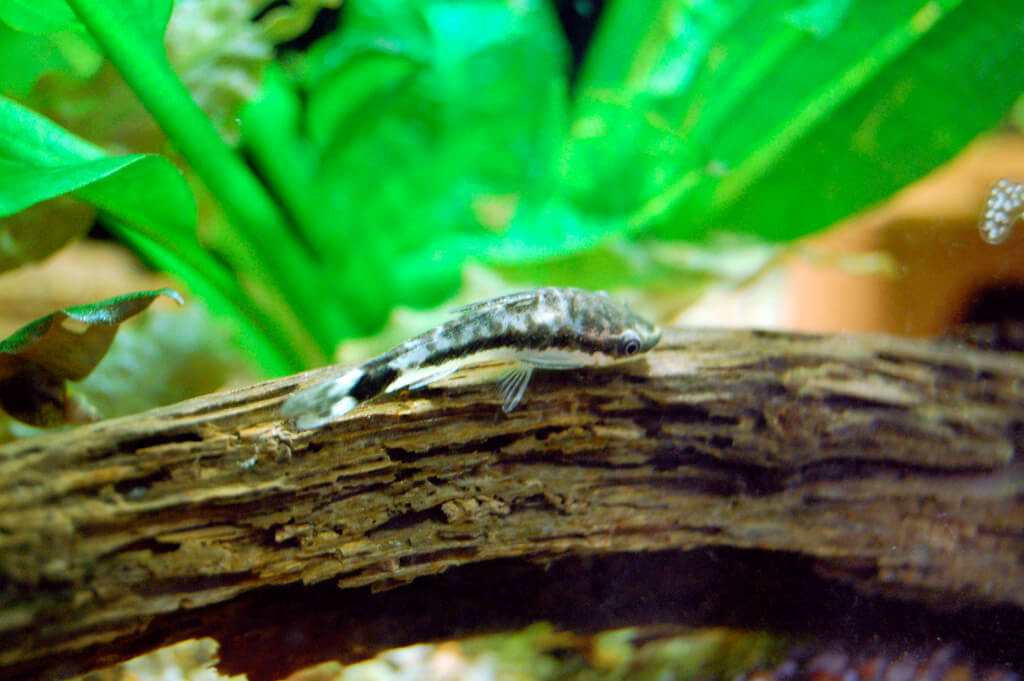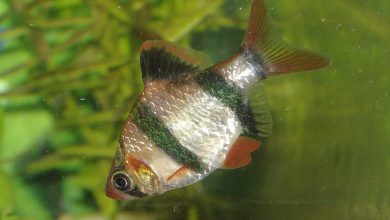Otocinclus Catfish Care

Popularly known as dwarf suckers or Otos, the Otocinclus is a popular fish species that is often kept in captivity. This is a type of catfish belonging to the family Loricariidae and is most commonly found in South America.
If you are looking for a new addition to your planted aquarium, the Otocinclus catfish is a safe bet as it is peaceful, helps keep algae in check and is easy to look after.
Despite having minimal needs, many hobbyists end up losing their Otos in the first month or so after buying the fish. There are many reasons for that, and most of these are concerned with the type of environment that you keep your fish in.
To help you avoid the common mistakes that fish owners make when they first bring in Otos into their aquariums, here is a comprehensive care sheet. It will walk you through all the basics that you need to know to take care of your fish!
Habitat

While the natural habitat of Otos is moderate or slow streams and rivers of South America that have good amounts of oxygen, this fish can survive well in planted aquariums as well.
They are fun to have, as they are very active, showcasing their personality at all times of the day.
In order to keep them happy, you will have to keep certain key factors under control.
Tank Size
Otos are very small – about 1.5 to 2 inches when they mature completely. This means they don’t need a very large tank.
You must, however, keep in mind that Otos are very social. This means that at least six or more should be kept together.
If you are sticking to just 6 Otos, a 10 gallon tank can work. If you want to scale up to 10-15 Otos, it is recommended that you invest in a 20 gallon tank.
It is also easier to maintain a wholesome ecosystem in the bigger tanks, which is important regardless of the type of fish you are keeping.
Water Temperature
The ideal temperature that you should aim for is between 72°F and 82°F (22-28°C). This temperature will have to be maintained at all times as these are tropical freshwater fish that need the right temperature to flourish.
They do not need any special lighting in the tank so your standard community tank lighting should work well enough.
Water Composition
This is where things get a little tricky.
Otos cannot survive in dirty water so you need to ensure that you have a good quality mature filter.
This filter should be able to process the water in the aquarium at least three to four times each hour. This is measured by the filter’s GPH rating.
It is important that the tank has no measurable quantity of ammonia or nitrite.
In addition to this, the nitrate level should be between 0 and 20 ppm for a healthy habitat.
Try to change about 30% of the water every week so that the system is refreshed regularly.
The pH of the aquarium should be kept at a neutral or slightly acidic level. This translates to a pH value between 6 and 7.5.
Equipment and Plants
The most important piece of equipment – the water filter – has already been discussed before. In addition to this, you will need to install a good quality aeration system and a mechanism for water circulation.
This is where an air pump and water pump come into play.
Standard lighting requirements call for LED lighting that doesn’t have a detrimental effect on the fish or other elements of the tank.
You will also need to purchase a CO2 injector, which is essential for all planted aquariums, and a bunch of test kits to measure the levels of ammonia, nitrites and nitrates in the tank.
You can place rounded and smooth stones, along with pre-soaked branches into the aquarium so that the Otos have enough space to graze.
Make sure that there are no sharp edges where the fish can harm themselves. Such cases can lead to an outbreak of disease within the aquarium, which is something you want to avoid at all costs.
There are a number of plant varieties that you can grow in your aquarium. It is important, however, that these are slow-growing plants as the faster ones will consume all the carbon dioxide before the algae gets a chance to grow.
Otos graze on algae so the presence of these aquatic organisms is essential for their growth.
Some good options for slow-growing plants are Anubius, Java ferns, Cabomba and Cryptocorynes.
Integration into the Tank
Once you have bought your Otos, you cannot simply introduce them into your tank. They first need to be quarantined. This means placing them in a separate tank with similar composition for a fixed period of time before moving them to the main tank.
This process can take up to a few weeks but it is essential so that you can gauge whether your fish are healthy. Otherwise, you stand the chance of infecting your entire fish tank by introducing disease-ridden Otos.
It is also important that you allow for some algae growth in the tank before Otos are introduced. This will help in ensuring that your fish have some food to graze on when they are finally placed in the main tank.
You will have to closely monitor the activity of your Otos during their first month in the fish tank. If they get by just fine, it is highly likely that you will be able to have them around for a long time with proper care.
Best Tank Mates


Not all types of fish work well together. You cannot simply pick the most colorful or attractive fish and put them all together in one big fish tank.
There are a number of factors that need to be considered.
Firstly, all the fish should have similar water composition requirements. You cannot put one fish that needs higher temperatures and another one that needs lower temperatures and expect them to survive together.
Relatively small and peaceful fish make for the best tank mates when it comes to Otocinclus catfish.
Some recommendations if you are looking to add other fish to the tank are Boraras, Dwarf Gouramis, Neon Tetras and Rasbora. These do not directly compete with Otos for nutrition or threaten their safety in any manner.
Fish That Don’t Work Well


Any type of big or aggressive fish can be considered dangerous when it comes to the small and peaceful Otos. Otocinclus catfish can easily get scared of bigger fish or even be eaten by them if you do not put enough thought into what fish is going to be living with the Otos.
Even fish that aren’t naturally predatory, like the goldfish, can end up eating Otos because of their small size. Other fish to avoid include Cichlids, Jack Dempsey (as they eat almost anything smaller than them) and Oscars.
Feeding
Figuring out the right kind of food to feed your Otocinclus catfish is another important consideration. Here’s what a well-balanced diet for Otos looks like…
Algae
Otos are algae eaters and can commonly be confused with other types of fish – like Chinese Algae Eaters, Siamese Flying Fox and Siamese Algae Eaters.
It is important that you introduce Otos into planted tanks that are stable and mature, with lots of algae growth. The soft green algae that grows on different surfaces is most readily consumed by Otos. In some cases, Otos are also seen eating brown algae or diatoms.
While algae can be their primary source of nutrients, most aquariums do not have enough algae growth to sustain large shoals. This means you may have to supplement their diet with other foods.
This food can be in the form of algae wafers (loaded with essential nutrients) or catfish pellets – specialized food developed to give catfish their required nutrition.
Vegetables
In addition to the algae and supplements that are commonly fed to Otos, you can also use some of the vegetables that you eat on a regular basis. Some examples of such vegetables are spinach, romaine lettuce, Brussel sprouts and zucchini.
You will need to blanch these vegetables before they can be introduced into the aquarium. This means adding the vegetables to boiled water, letting it rest for a short period of time in it, and then moving it to cold water. This stops the cooking immediately.
Otos do not automatically gravitate towards these vegetables so you may find yourself waiting for them to discover your carefully-prepared vegetables. Be sure to remove any uneaten vegetable matter to prevent it rotting and causing issues with your water chemistry.
Buying Your Fish
Many Otocinclus catfish owners notice their fish dying within the initial month or two of owning them. It can be a confusing situation, especially if you have taken good care and maintained ideal conditions in the tank.
It is important that you personally visit your local fish store and only buy your Otos after examining the specimens on offer. Ask questions like how long the fish have been in the store – if they’ve been there a while, they are more likely to last – or what is being fed to them. Look at the fish and check if they look healthy.
Signs of Healthy Oto Catfish
There are a number of signs that show whether a fish is healthy or not. This isn’t just important when you are buying the fish. It is also important that these signs continue to show when the fish have been in your aquarium for a while.
- The fish should have a good color (black, white or brown) and not look grayish.
- There shouldn’t be any bloody marks on the fish.
- Rounded – not bloated – bellies that are a sign of a well-fed fish.
- Two sharp points on the edge of their fins.
Signs That Something Is Wrong
There can be a number of different problems that arise when you are taking care of your fish. For example, if you notice the fish coming up to the surface to take in air, there could be a problem with the air pump and the tank may be lacking oxygen. It is important that you fix it immediately.
There are other symptoms that are indicative of health problems. Some of these are listed below:
- Breathing heavily
- Reduction in regular appetite
- Prolonged periods of inactivity
If you notice any of these, your fish may be suffering from a disease. Some of the common problems at this stage are fungal and parasitic infections. It is recommended that you consult a veterinarian in such cases.
Conclusion
Otocinclus catfish make for great additions to your aquarium. Not only are they active and interesting to look at, they are also relatively easy to take care of. Once you are able to get through the initial month or so when most of the casualties take place, you will be able to enjoy enjoy watching your dwarf suckers for a long time to come.
Photos c/o bert_m_b, stee & Carlos Reusser Monsálvez 


